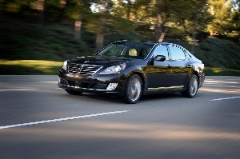 AboutThatCar.com
AboutThatCar.com
By Frank S. Washington
SUPERIOR TWP, MI – Hyundai invited reporters to its technical center here to get a look at and a test drive of the mid-cycle changes it has made to its flagship sedan, the 2014 Hyundai Equus.
More reporters showed up than Hyundai had cars for to conduct the normal two-to-a-car test drive, 41 scribes versus 15 cars. In some instances that meant three to a car. Hyundai is one of the hottest brands in the market; its six-month sales of more than 360,000 are the best in its history in the U.S. market.
As the brand continues to move upstream, the Equus is Hyundai’s attempt to take on the best luxury marques in the world. Hence, that explains the more than expected curiosity about what the Korean automaker had done to its flagship.
The car is still powered by a direct injected 5.0-liter V8 that makes 429 horsepower and 372 pound feet of torque. It generates 421 horsepower using regular fuel. The engine is mated to an eight-speed automatic transmission. The combination gets 15 mpg in the city, 23 mpg on the highway and a combined 18 mpg.
This powertrain was smooth, gear selection was buttery and the engine was rhythmic during acceleration. The steering ratio could be tightened a tad; there was a little too much play in the response to driver input. But it wasn’t anything a normal driver would notice.
A few exterior changes were made. Hyundai dumped the chrome accents on the front and rear bumpers to get a more reserved and sophisticated look. LED fog lights are now standard. Side mirrors and tail lamps have been redesigned and the front bumper fascia and grille design have been tweaked. There was also a new wheel design; 19-inch polished silver wheels now simulate the turbine blades of a jet engine.
Bigger changes were made to the interior. Hyundai has dropped the Equus’ center stack in favor of a horizontal layout. It was a smart move; center stacks look old as the industry moves to horizontal layouts at all levels.
However, in the new setup, the navigation screen is close enough to the driver that it looks like a touch screen but it is not. Never fail to meet the customers’ expectations. It’s too late for Hyundai to do anything about it now but it’s something to remember in future models.
The 2014 Equus now has a snow mode ride setting in addition to its normal and sport settings. We never tried anything but normal but found it to be American in temperament. In other words, the normal setting didn’t ape the firm rides of European luxury sedans. The car rode soft without being cushy or floaty. It was obvious to us that Equus has chosen its own path.
For 2014, the Equus has a larger TFT (thin film transistor) center cluster display on the Signature model and a 12.3-inch, fully-digital TFT LCD center cluster display for Ultimate model and a larger center instrument panel LCD display. The instrument display is part mechanical on the Signature model and all image projection on the Ultimate model.
Dual high-resolution 9.2-inch rear seat entertainment monitors are available. They replace the single monitor for rear seat entertainment. And a rear seat passenger can now control the audio system as well as climate control and some other aspects of the car from the rear seat console.
The Equus is chock full of creature comforts. Heated and cooled rear seats that are adjustable, adaptable cruise control that has full stop as well as resume forward movement capability and a blind spot alert monitor in the heads-up display are all available. The car even had power rear side window shade screens.
Hyundai is using the same formula that Japanese luxury brands used a generation ago to crack the U.S. luxury car market. Offer a comparable product for less. In the case of the Equus, Hyundai is offering a comparable product for a lot less.
The company has just two trim lines for the Equus. The Signature model is $61,200 and the Ultimate model is $68,920. The extra 7K gets you stuff like the heads up display, a forward view cornering camera as well as a multi view camera system, power rear seat and head rests, cooled rear power seats and a power trunk lid.
However, the Equus has one distinct disadvantage, it does not have an all-wheel-drive version – but it is coming. As an automaker you can’t really compete in all quadrants of the country, especially the northern tiers, without all-wheel-drive. So it’s not a matter of if the Equus will be equipped with AWD, the question is when.
Frank S. Washington is editor of AboutThatCar.com.



